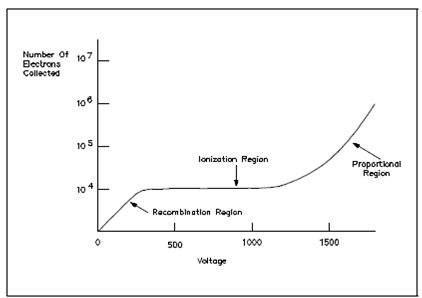Gas Ionization Curve:
To a limited degree, the fill-gas will determine what type of radiation the proportional counter will be able to detect. Helium and Argon are the most often used fill gases and permit for the detection of alpha, beta, and gamma radiation. While detection of neutrons is essential, the detectors are commonly filled along with boron-triflouride gas.
The simplified circuit, described within Figure, displays in which the detector wall acts as one electrode, although the other electrode is a fine wire in the middle of the chamber along with a positive voltage applied.
Figure describes how a number of electrons collected varies along with the applied voltage.
While a single gamma ray interacts along with the gas in the

Figure: Gas Ionization Curve
chamber, it generates a rapidly moving electron that generates secondary electrons. About 10,000 electrons might be established depending on the gas used in the chamber. The applied voltage could be increased until the amount of recombination is extremely low. Therefore, additional increases do not appreciably raise the number of electrons collected. This region within that all 10,000 electrons are collected is the ionization region.
As applied voltage is increased above 1000 V, the number of electrons becomes greater than the initial 10,000. The further electrons that are collected are because of gas amplification. As voltage is raise, the velocity of the 10,000 electrons generates increases. Therefore, beyond a definite voltage, the 10,000 electrons are accelerated to like speeds which they have sufficient energy to cause more ionization. This phenomenon is known as gas amplification.
As an instance, if the 10,000 electrons generated through the gamma ray are increased to 40,000 through gas amplification, an amplification factor would be 4. A Gas amplification factors can range from unity in the ionization region to 103 or 104 in the proportional region. High amplification factor of the proportional counter is the main benefits over the ionization chamber. An internal amplification of the proportional counter is like in which low energy particles (< 10 KeV) could be registered while the ion chamber is limited by amplifier noise to particles of > 10 KeV energy.